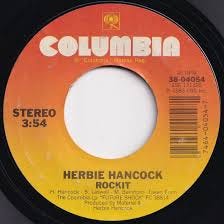Five Sounds and Instruments Heard in Herbie Hancock’s Hip-Hop/Jazz Amalgam “Rockit”
This electric eighties jam from a jazz veteran helped make hip-hop mainstream.
The song “Rockit” by Herbie Hancock came around the time when hip-hop music was still new and unfamiliar to mainstream audiences. By combining the art of “scratching” vinyl records with a jazz sensibility, it helped legitimize the sound born of DJ house parties and inner city streets.
Hancock used more than scratches and samples on the song, though.
Herbie Hancock in the sixties and seventies
The Chicago native graduated from Grinnell College in Iowa in 1960 (he’d later earn an honorary doctorate from his alma mater) before joining Miles Davis’ second Great Quintet three years later.
Hancock also worked as a sideman for other musicians, recorded solo records, and TV commercials, as well as the score to the film Blowup. In 1969 he composed the soundtrack to Bill Cosby’s Fat Albert prime-time special.
In the seventies, he first ventured into electronic music with synthesizers and a vocoder. He worked on more film soundtracks, including Death Wish, and recorded with Chick Corea and Wynton Marsalis, among others.
By the latter part of the decade, hip-hop had been born.
Future Shock and the genesis of “Rockit”
In 1983, Hancock released his thirty-fifth album, Future Shock, produced by Hancock and Bill Laswell & Michael Beinhorn of the band Material.
Hancock’s career floundered in the early eighties. He first heard DJ scratching on the Malcolm McLaren tune “Buffalo Gals” and on Material tracks. His manager encouraged the Material duo to record demos with him. The album grew from there.
Laswell, in the liner notes to the 1999 remastered edition of Future Shock, describes how he brought Hancock into the hip-hop scene in the early eighties:
…we used to go a lot at that time to the Roxy which was I think was on 18th or 19th Street on the West Side [actually 18th Street]. So I would go there a lot and the head DJ there was Afrika Bambaataa and he had a disciple called Africa Islam. And inside of that crew was also a person called DST [aka GrandMixer DXT] and Grand Master Flash and everybody would work there, and do their thing. And we would go there every night and just absorb what was happening with that particular culture. I remember even before we did the track, the initial two tracks with Herbie, we took Herbie to the Roxy. And Bambaataa was DJing and I don’t think he pays a lot of attention to what was going on with the music, but he was in the environment where it was all sort of happening.
Hancock combined DJ scratching with electronic music on “Rockit,” using:
1. Synthesizers
Hancock used a Fairlight CMI, a combination synthesizer, sampler and digital audio workstation created in 1979 in Australia. He used three of them on “Rockit,” overdubbing each one.
This article discusses the history of the Fairlight and sampling in general. It includes a video of Hancock using the Fairlight on an episode of Sesame Street.
Early adopters of the Fairlight besides Hancock included Peter Gabriel, Stevie Wonder and Kate Bush. This video demonstrates its use.
The melody came from an improvisation by Hancock, Laswell and Beinhorn.
Also, Hancock spoke on the song through a vocoder.
2. Samples
Laswell created the samples. The song title was taken from the sample of Bambaataa’s hit “Planet Rock,” when he says “Rock it don’t stop it.”
Laswell was going to sample a Led Zeppelin snare, but a phone call distracted him and he picked up a guitar chord instead. He went with it.
3. Synth drums
Beinhorn used the Oberheim DMX, a programmable, digital drum machine introduced in 1980. This video explains how it works. He also used a Minimoog.
With the DMX, producers went from sampling beats and loops directly from records to working from individual channels that made sounds such as bass, snare, hi-hat and cymbals.
4. Batá drums
Cuban percussionist Daniel Ponce used batá drums. The batá is a double-headed drum shaped like an hourglass. It comes in three sizes. Originally from Nigeria, it can be heard in Santeria religious practices in Cuba, among other places. Jazz musicians associated with the batá include Chucho Valdes and Victor Torres.
When recording “Rockit,” instead of having three people play on the batá drums, Ponce played individually on each drum. Laswell has said the rhythms Ponce played were associated with Yoruba deities.
5. Turntables
D.ST handled the turntables, with help from Infinity Rappers Mr. C and Boo-Ski, plus Grandmaster Caz.
In the book Yes Yes Y’all: The Experience Music Project Oral History of Hip-Hop’s First Decade, compiled by Jim Fricke and Charlie Ahearn, legendary DJ Grandmaster Flash describes how the technique of scratching a record began, by highlighting “the get down part,” later known as the break, and making it last longer:
…I was saying to myself, “Well, if I can figure out how to take the music that I love, where the break is so short, extend them particular sections, and make them as long as I chose to, that would really be the way to go.”…I had created a new style of DJ-ing, so to some degree I was ridiculed by all the other jocks that was doing the other style of DJ-ing, saying that I destroy records and that what I’m doing is not a good style.
In time, the technique caught on.
On “Rockit,” D.ST took the B-side of Fab 5 Freddy’s “Change the Beat” and scratched the word “fresh.” He only needed one take.
The video for “Rockit” is amazing, too. Co-director
Kevin Godley discusses it (and other videos) in this great interview.
Hancock won the Grammy for Best R&B Instrumental Performance for “Rockit,” plus five MTV Video Music Awards.
@byrichwatson
PLUS: Here’s Hancock performing “Rockit” live at the 1984 Grammy Awards.
———
Do you remember the song “Rockit”?


